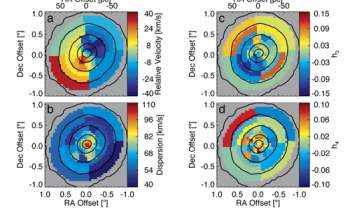sci14044 — Announcement
A Supermassive Black Hole in an Extremely Small Galaxy
September 25, 2014
Anil Seth (University of Utah) and colleagues discovered that an ultracompact dwarf galaxy harbors a supermassive black hole – the smallest galaxy known to contain such a supermassive object. The team obtained high spatial resolution kinematic data using the Near-Infrared Integral Field Spectrometer (NIFS) and the laser guide star adaptive optics system on Gemini North to measure the black hole’s mass, which they found to be about 21 million solar masses. This accounts for some 15% of the total mass of the ultracompact dwarf galaxy. The extremely large black hole mass fraction, and relatively normal stellar mass to light ratio of this object, called M60-UCD1, suggest that it is the remains of a tidally-stripped galaxy. More information and links to video simulations are available on the Gemini web page, and the full results are published in Nature (subscription required).
About the Announcement
| Id: |
ID
sci14044
|
